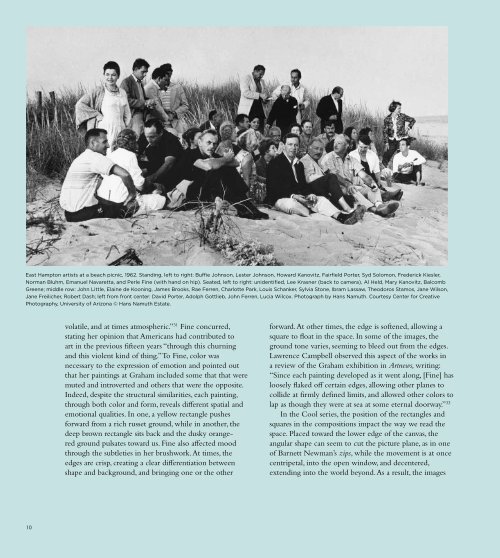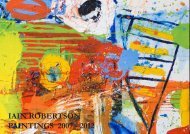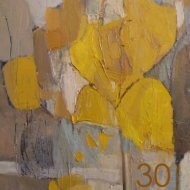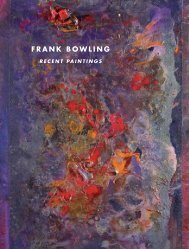Perle Fine - Abstract Critical
Perle Fine - Abstract Critical
Perle Fine - Abstract Critical
You also want an ePaper? Increase the reach of your titles
YUMPU automatically turns print PDFs into web optimized ePapers that Google loves.
East Hampton artists at a beach picnic, 1962. Standing, left to right: Buffie Johnson, Lester Johnson, Howard Kanovitz, Fairfield Porter, Syd Solomon, Frederick Kiesler,<br />
Norman Bluhm, Emanuel Navaretta, and <strong>Perle</strong> <strong>Fine</strong> (with hand on hip). Seated, left to right: unidentified, Lee Krasner (back to camera), Al Held, Mary Kanovitz, Balcomb<br />
Greene; middle row: John Little, Elaine de Kooning, James Brooks, Rae Ferren, Charlotte Park, Louis Schanker, Sylvia Stone, Ibram Lassaw, Theodoros Stamos, Jane Wilson,<br />
Jane Freilicher, Robert Dash; left from front center: David Porter, Adolph Gottlieb, John Ferren, Lucia Wilcox. Photograph by Hans Namuth. Courtesy Center for Creative<br />
Photography, University of Arizona © Hans Namuth Estate.<br />
volatile, and at times atmospheric.” 31 <strong>Fine</strong> concurred,<br />
stating her opinion that Americans had contributed to<br />
art in the previous Wfteen years “through this churning<br />
and this violent kind of thing.” To <strong>Fine</strong>, color was<br />
necessary to the expression of emotion and pointed out<br />
that her paintings at Graham included some that that were<br />
muted and introverted and others that were the opposite.<br />
Indeed, despite the structural similarities, each painting,<br />
through both color and form, reveals diVerent spatial and<br />
emotional qualities. In one, a yellow rectangle pushes<br />
forward from a rich russet ground, while in another, the<br />
deep brown rectangle sits back and the dusky orangered<br />
ground pulsates toward us. <strong>Fine</strong> also aVected mood<br />
through the subtleties in her brushwork. At times, the<br />
edges are crisp, creating a clear diVerentiation between<br />
shape and background, and bringing one or the other<br />
forward. At other times, the edge is softened, allowing a<br />
square to Xoat in the space. In some of the images, the<br />
ground tone varies, seeming to bleed out from the edges.<br />
Lawrence Campbell observed this aspect of the works in<br />
a review of the Graham exhibition in Artnews, writing:<br />
“Since each painting developed as it went along, [<strong>Fine</strong>] has<br />
loosely Xaked oV certain edges, allowing other planes to<br />
collide at Wrmly deWned limits, and allowed other colors to<br />
lap as though they were at sea at some eternal doorway.” 32<br />
In the Cool series, the position of the rectangles and<br />
squares in the compositions impact the way we read the<br />
space. Placed toward the lower edge of the canvas, the<br />
angular shape can seem to cut the picture plane, as in one<br />
of Barnett Newman’s zips, while the movement is at once<br />
centripetal, into the open window, and decentered,<br />
extend ing into the world beyond. As a result, the images<br />
10





